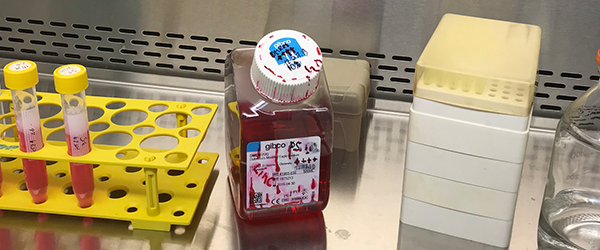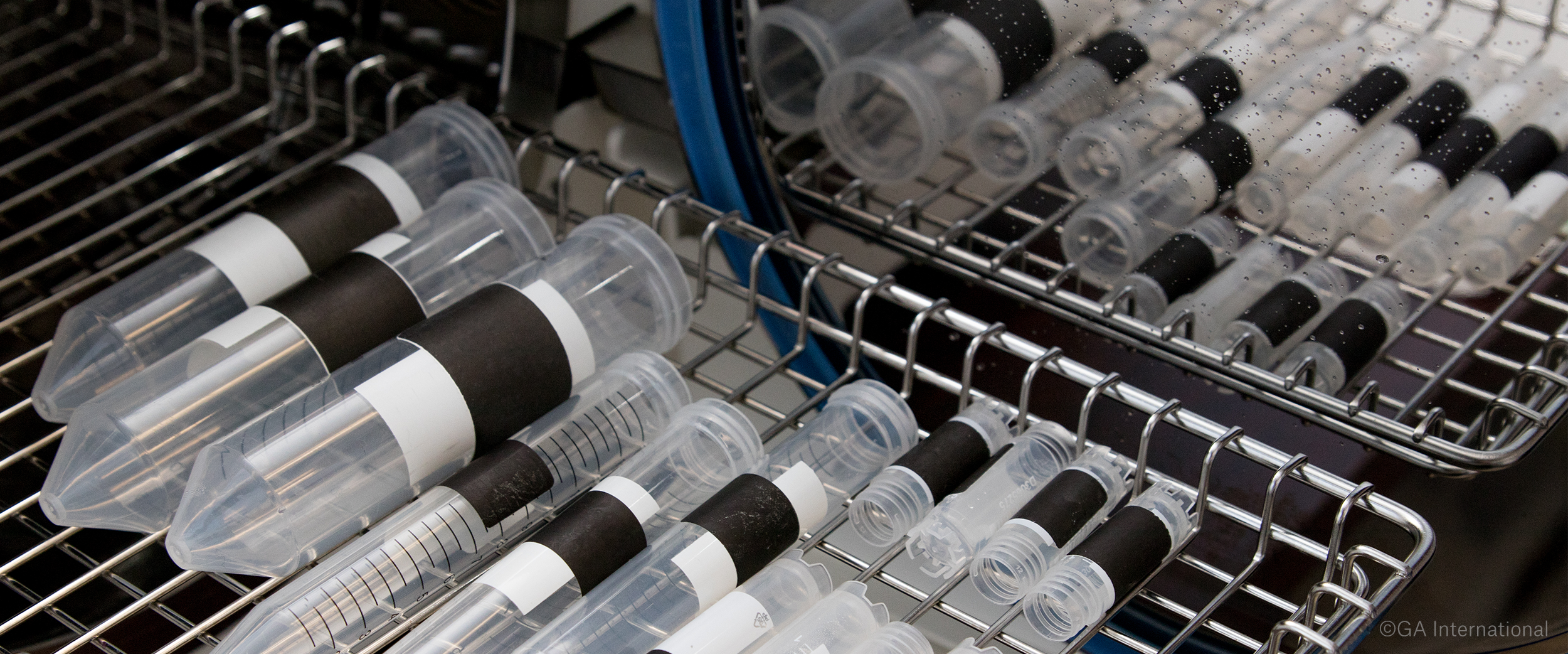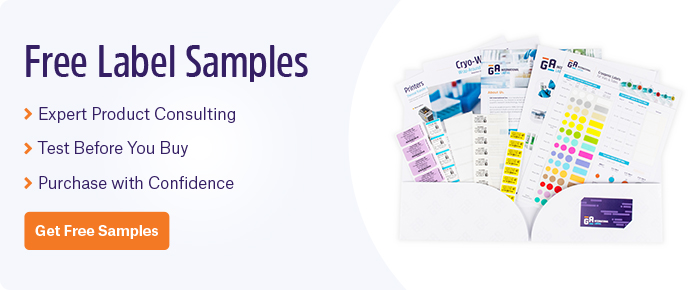 There are many ways to label samples in the lab, though some of these may not be particularly efficient. Here, we’ll review common labeling pitfalls and provide tips to remedy them, which will make your lab more productive and organized.
There are many ways to label samples in the lab, though some of these may not be particularly efficient. Here, we’ll review common labeling pitfalls and provide tips to remedy them, which will make your lab more productive and organized.
#1 – Handwriting on tubes
Though handwriting is frequently used in biomedical labs, it’s one of the least efficient ways to label containers. Writing on small tubes takes time (especially for assays with hundreds of samples to process), provides a small surface on which to inscribe the necessary information, and depends on having clear, legible handwriting. Once all the tubes are labeled, the writing risks rubbing off or smudging if exposed to solvents, extreme temperatures, or abrasion. With a label printer, it’s easier to organize and plan labeling ahead of time, letting the printer do all the work. Using the right labels with the appropriate printing method means they’ll stay affixed to your tubes without the ink smudging or rubbing off. If you must handwrite on tubes, then make sure you use waterproof cryo markers, which resist cryogenic storage.
#2 – Using the wrong labels
Not all labels are made equal. Many are specialized for a variety of harsh environments, such as cryogenic storage, sterilization, and chemical exposure. Before choosing a label, it’s worth knowing its working temperature range and the conditions it’ll encounter. For instance, you would not use the same label biobanks and in vitro fertilization (IVF) facilities use for cryogenic storage of samples as you would in a histology lab to identify microscope slides prepared for histological staining. One requires labels that resist extended storage in liquid nitrogen (-196°C), while the other necessitates chemical-resistant labels; however, use a label in the wrong application, and it would likely fail.
#3 – Not testing your labels first
It’s important to buy labels from a specialized label manufacturer because they’ll test a small sample from each batch post-production. This is especially important for specialty labels, as you need to be sure they will consistently resist the laboratory environment(s) they’re destined to encounter. However, not all lab environments are tested by the manufacturer. As such, it’s always recommended to obtain a sample of the label beforehand and test it in your exact working conditions. This will help ensure they won’t fail when you perform the full assay with your precious specimens.
#4 – Not optimizing the labeling process
Automation is the most efficient way of optimizing labeling in the lab. Automated labeling systems can perform a host of functions, including labeling, capping/decapping, and liquid dispensing, that will save time and effort, yielding more walk-away time to perform other, more important tasks. Automated print-and-apply systems usually work with thermal-transfer printers, though some also employ direct thermal printers. This allows them to use high-quality thermal labels and to print high-grade barcodes, which are sure to remain scannable throughout their use.
#5 – Not using barcodes
Barcodes are one of the best ways to track and trace samples and inventory. It’s no surprise most industrial labs integrate barcode labels with their laboratory information management system (LIMS) to generate traceable products and documentation. IVF facilities have even begun using electronic witnessing systems (EWS), paired with barcode labels, to ensure patients samples aren’t mixed up during a procedure. There are many different types of 1D and 2D barcodes, each with its own pros and cons. Scanning samples into a LIMS, which acts as a directory for your inventory and workflow, makes it easier to follow large batches of samples, especially when they require processing in multiple steps.
#6 – Installing labeling software that doesn’t meet your needs
If you’ve bought a printer and use the free software that came with it, it’s possible you might not have access to many barcoding options available with specialized label printing software, like BarTender™. Specialized software can provide you with options like printing logos and designs as well as more variety for serialization and barcodes. You might also have a custom database of information that needs to be imported into your printing software, which is typically only possible with specialized software. Furthermore, if you’re using a LIMS, verify if it comes with its own proprietary printing software or if your existing label printing software is compatible with it.
#7 – Labeling only for yourself
Once you’ve finished writing your thesis and accepted a position in a new lab, the project isn’t over. Someone will invariably need to sift through your data to corroborate experiments or assess how you performed them to continue building on your findings. Unfortunately, it can often be extremely difficult to track old experiments, especially when lab books haven’t been properly organized, making it difficult to match the data points of each experiment to the tabulated results. Merely finding a specimen could require guesswork if they aren’t arranged appropriately. Therefore, it’s imperative to not simply label things in a way that only you can decode. Instead, devise a labeling system for samples, results, and inventory that consists of either serialization or, preferably, 1D or 2D barcodes. This will increase the traceability of your samples so that anyone can find them in addition to improving your ability to track and organize results.
 #8 – Using direct thermal labels in the autoclave
#8 – Using direct thermal labels in the autoclave
If you use a lot of direct thermal labels in the lab, including those that are made for DYMO printers, the one thing to avoid is affixing them to containers destined for sterilization. Direct thermal labels come coated with a leuco dye, which reacts to heat. Direct thermal printers precisely apply heat to the labels, making the leuco dye on the label turn black. Unfortunately, autoclaves also supply enough heat to turn your labels completely black, masking all information previously printed on them. Therefore, unless the intent is to obscure sensitive information, direct thermal labels should not be used on autoclaved material. Direct thermal labels are also sensitive to chemical exposure, so be sure to use another kind of label when performing assays that require solvents like xylene, alcohol, or any other harsh solutions.
#9 – Improperly labeled samples in cryogenic storage
In labs that process hundreds or even thousands of samples daily, it’s easy to make a mistake. The real problem is when you think you’ve labeled your vials appropriately, only to store them in liquid nitrogen and realize later that the samples aren’t identified correctly. The tubes or vials are then impossible to write on, even when using cryo markers, because they’re frozen, making it especially difficult to correct the error. It may seem tempting to partially defrost a tube or vial to relabel it, but this is never a good idea, as freeze/thawing samples is likely to either kill your cells or degrade your specimen. The only proper way to correct this mistake is by using labels that can affix to already cryogenically frozen tubes, such as CryoSTUCK® labels, printed with a thermal-transfer printer.
LabTAG by GA International is a leading manufacturer of high-performance specialty labels and a supplier of identification solutions used in research and medical labs as well as healthcare institutions.




